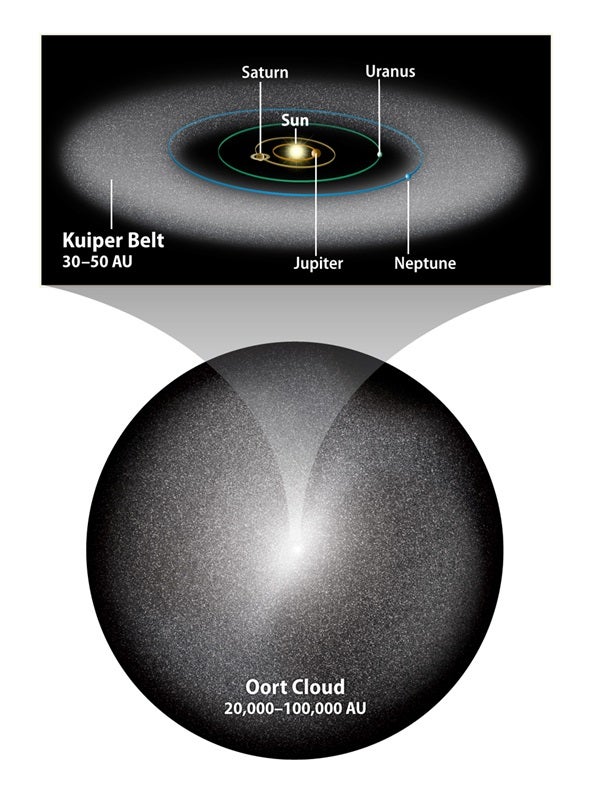Kuiper Belt and Oort Cloud objects can exert gravitational effects on the planets, but the real question is whether such perturbations are detectable. Based on the observation that long-period comets can appear in any part of the sky, we generally think that the Oort Cloud of comets is a near-spherical structure surrounding the solar system at a distance of about 20,000 to 100,000 astronomical units (AU, which is the average Earth-Sun distance) from our star. The nearly spherical nature of the cloud means that there would be no net gravitational effect on planetary orbits — all of the small gravitational pulls would cancel one another out.
On the other hand, the Kuiper Belt, located between 30 and 50 AU from the Sun, has a more flattened structure with a total mass of perhaps 0.1 that of Earth. In principle, the belt’s characteristics would contribute to the precession of Neptune’s orbit (i.e., rotation of the ellipse) of approximately 0.1 arcsecond per century, with correspondingly smaller effects on the planets closer to the Sun. To put this value in perspective, it is more than 400 times smaller than the anomalous precession of Mercury’s orbit that results from general relativity; the effects are below the current level of detectability.
However, scientists have already detected the gravitation-al effects of the smaller members of the solar system on the orbit of a planet — analysis of radio ranging data with better than 12-meter accuracy obtained from the Viking landers on Mars between 1976 and 1981 enabled Myles Standish and Ron Hellings to estimate the masses of the asteroids Ceres, Pallas, and Vesta. In principle, the same could be done for Kuiper Belt objects if we had a sufficiently accurate signal source at a known location.
On the other hand, the Kuiper Belt, located between 30 and 50 AU from the Sun, has a more flattened structure with a total mass of perhaps 0.1 that of Earth. In principle, the belt’s characteristics would contribute to the precession of Neptune’s orbit (i.e., rotation of the ellipse) of approximately 0.1 arcsecond per century, with correspondingly smaller effects on the planets closer to the Sun. To put this value in perspective, it is more than 400 times smaller than the anomalous precession of Mercury’s orbit that results from general relativity; the effects are below the current level of detectability.
However, scientists have already detected the gravitation-al effects of the smaller members of the solar system on the orbit of a planet — analysis of radio ranging data with better than 12-meter accuracy obtained from the Viking landers on Mars between 1976 and 1981 enabled Myles Standish and Ron Hellings to estimate the masses of the asteroids Ceres, Pallas, and Vesta. In principle, the same could be done for Kuiper Belt objects if we had a sufficiently accurate signal source at a known location.
Carl Murray
Queen Mary University of London
Queen Mary University of London










